May 17th, 2017
I had the privilege of documenting the most beautiful day of our trip so far in Poland. Our morning started with meeting up with our awesome tour guide, Anna Baryla, who we had already met two days prior when she took us around the Jewish Quarter in Krakow. Today, we toured the Royal City of Krakow that is 1000 years old and learned about the history of the city.
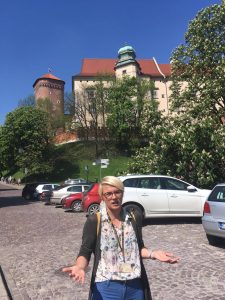
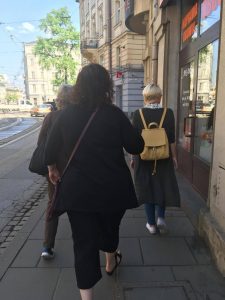
Anna told us that in the year 965, Jewish merchant names were first documented under Mieszko I, the first documented ruler in Poland. Ibrahim ibn Yaqui wrote the Chronicle. In the year 966, the written history of Poland began. In the 13th century, the city of Krakow was almost completely destroyed by Mongols.
We proceeded to learn about the Wawel Royal Castle which used to be the center of the city. The Main Market Square became the center of the city after the city was rebuilt. The castle was built under the reign of King Casimir III The Great. The names of the donors who helped to fund the reconstruction are still displayed today on bricks. The cathedral next to the castle was rebuilt many times, but the castle wasn’t because the Mongols never went to the hill so it wasn’t destroyed.
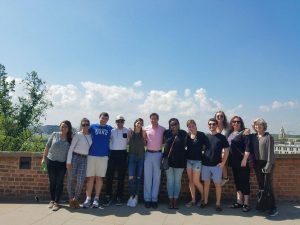
Anna also taught us about the tale of the dragon. There is a metal sculpture of the dragon on the foot of the hill by Vistula River, although the tale of the dragon is that he died by drinking too much water. The King wanted to marry off his daughter but also wanted to kill the dragon, so he offered his daughter’s hand in marriage to whoever could kill the dragon under the castle. Many suitors tried until this one man named Skuba put a lamb outside of the dragon’s den for him to eat which caused the dragon to become incredibly thirsty. The dragon would keep drinking water from Vistula River but could never quench his thirst, and the moral of the story is to not drink too much water. I wonder if that’s why bottles of water were so small in Poland and you had to pay for water at restaurants? The dragon’s bones now dangle in front of the entrance to the cathedral and the tale is said that as long as it is hanging there, everything will be okay.
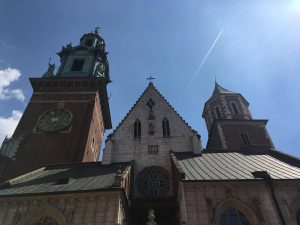
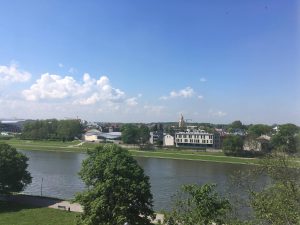
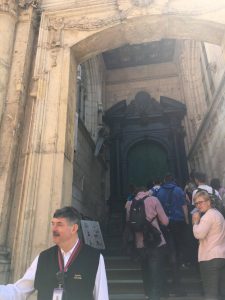
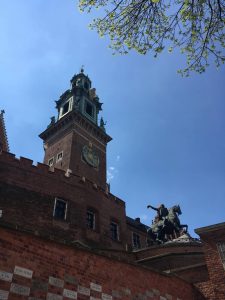
We then learned about the union between Poland and Lithuania which was started by the King and Queen Jadgiwa. In 1572, kings were first elected. In the 17th century, there were wards between Sweden, Russia, and the Ottoman Empire. In the 18th century, the Polish-Lithuanian Commonwealth was partitioned into three separate parts. Krakow was a part of the Austria-Hungary partition.
We then headed to the Courtyard of the Castle which was a beautiful place to take photos in front of. The design was created to force you to use the balconys to get to the other rooms. The ground floor was where servants lived, while the first floor was the private apartments of Polish Kings. On top of the castle is the Polish flag, which is red and white. The white symbolizes the eagle emblem of Poland, while the red symbolizes the attire of noblemen. 3000 people petitioned for the flag to be on top of the castle and it was approved. In 1918, the capital of Poland moved from Krakow to Warsaw.
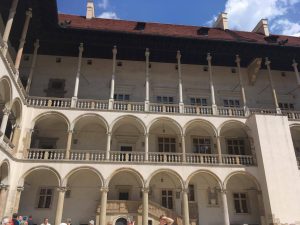
We then passed through the Main Market Square and Saint Mary Basilica Church. At the top of the tower of the church, a trumpet tune is played every hour and stops mid-tune to commemorate a trumpeter in the 13th century who was shot in the throat with a knife while he was playing. We also saw Eros Bendato, a sideways head bronze sculpture which was only supposed to be displayed until 2007 but remains today as a meeting spot.
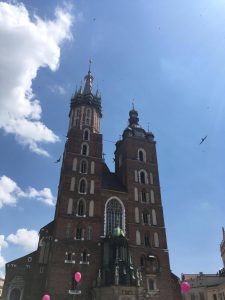
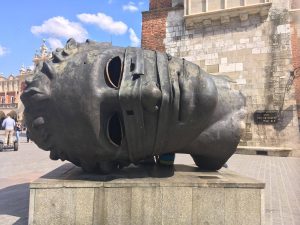
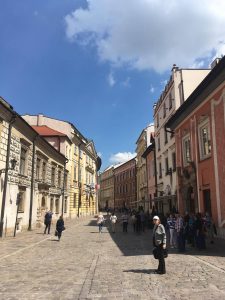
The cloth hall has many vendors that are selling souvenirs to tourists and the entrance has two forms of security. It has a typical security camera, but it also has a pigeon resting upon a dangling knife. The tale is that if you steal from the cloth hall, the pigeon will cause the knife to fall and cut your arm off.
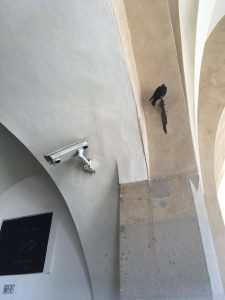
We also looked at three pieces of stained glass that weren’t allowed in Wawel Cathedral and are now displayed in Wyspiański Pavilion due to being deemed inappropriate. Henryk Pobożny was portrayed as being killed, Saint Stanislaw was portrayed as having a face of suffering, and King Casimir The Great was portrayed as being a skull. We then went to St. Francis’ Basilica to see more of Wyspiański’s stained glass art.
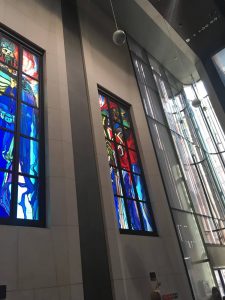
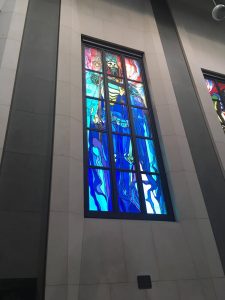
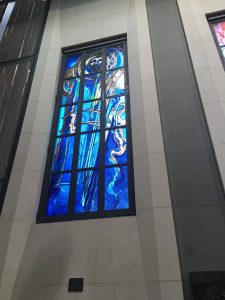
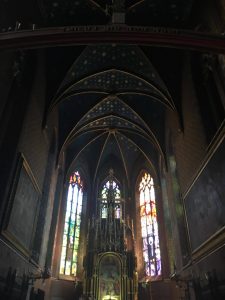
Our tour with Anna concluded at the Barbican gate which is a remnant of the Polish defense system. It was kept in Krakow with the argument that it would prevent wind from blowing into the market square. The Marilyn Monroe argument was that the wind would lift all of the women’s skirts and show their underwear which was the convincing piece to not tear down the gate.
We all gave hugs to Anna as she left us for another tour. It was a wonderful day learning about the Royal City of Krakow!
We then headed to Jagiellonian University where we met with 5 third-year students in their Jewish Studies Department (Kristopher, Jacet, Piotr, Julia, and Agnieszka). We also met with two professors in the department (Edyta Gawron and Marek Tuszewicki).
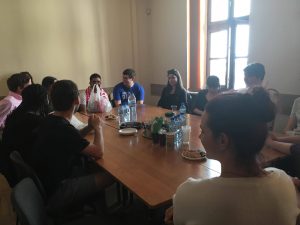
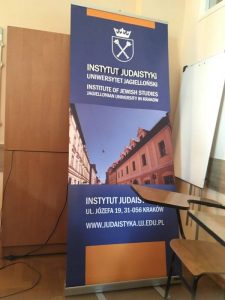
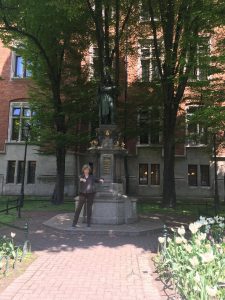
There are 12 universities in Krakow, all of which are tuition-free. Jagiellonian University is the oldest university in Poland and was founded in 1368. The Polish Queen Jadgiwa supported the university financially after the King died. Both Nicolas Copernicus and Pope John Paul IInd studied at this university.
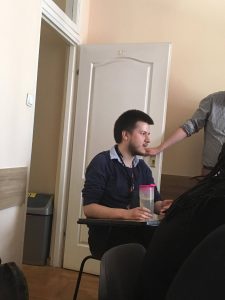

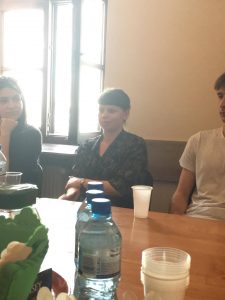
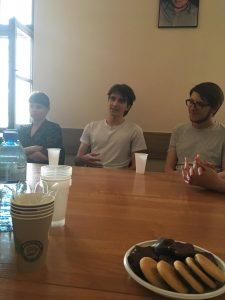
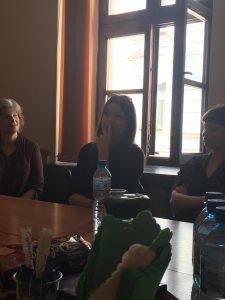
The Institute of Jewish Studies was founded in the mid 1980s. It was interesting to learn that the program enrolls about 40 students a year for the BA program plus another 40 students for the Masters program, but only about half of the students regularly show up to class. The Jewish Studies major is one of the hardest to get due to having to study both Yiddish and Hebrew for three years.
We learned about what made them choose to study Jewish Studies, how often they go to class, what they do in their free time, and what they want to do after graduation. They were very hospitable and even gave us cookies!

Many of them said that they liked Jewish Studies since it’s something they didn’t learn a lot about growing up besides going on the mandatory school trip to Auschwitz-Birkenau. When their families asked them why they chose this course of study, they responded by saying it was marketable both in the EU and in Israel by becoming fluent in Hebrew and Yiddish. For some of them, this was their second or third degree. Many of them said that they go to class for about 20 hours a week. They had their own opinions on which language they thought was easier than the other. In their free time, Kristopher watches Netflix and likes to create websites. Many of them also hold jobs outside of school. After graduation, many of them are hoping to be recruited by big companies that are looking for those who can speak Hebrew and Yiddish. The professors said that for those that have a Jewish Studies degree, they have had 100% job placement rate.
It was interesting to listen to Polish university students who grew up in a predominantly Catholic community and still chose to study Jewish Studies. It was inspiring to see their passion for learning something outside of their comfort zone and also realizing the importance of learning about the history of a group of people that contributed so much to the creation of their country.
We encouraged them to come visit their new friends in North Carolina and Kristopher said that he would love to watch House of Cards with all of us in America.
All of the Duke students were amazed at how the students from Jagiellonian University could speak Polish, English, Hebrew, and Yiddish so well and really enjoyed learning about the culture of college students in Poland. It was definitely one of my highlights of the trip and I am excited to keep in touch with everyone we met over social media.
After leaving Jagiellonian University, we went back to the Golden Tulip Hotel and rested before we met again for dinner.
Dziękuję Anna and Jagiellonian University students!
